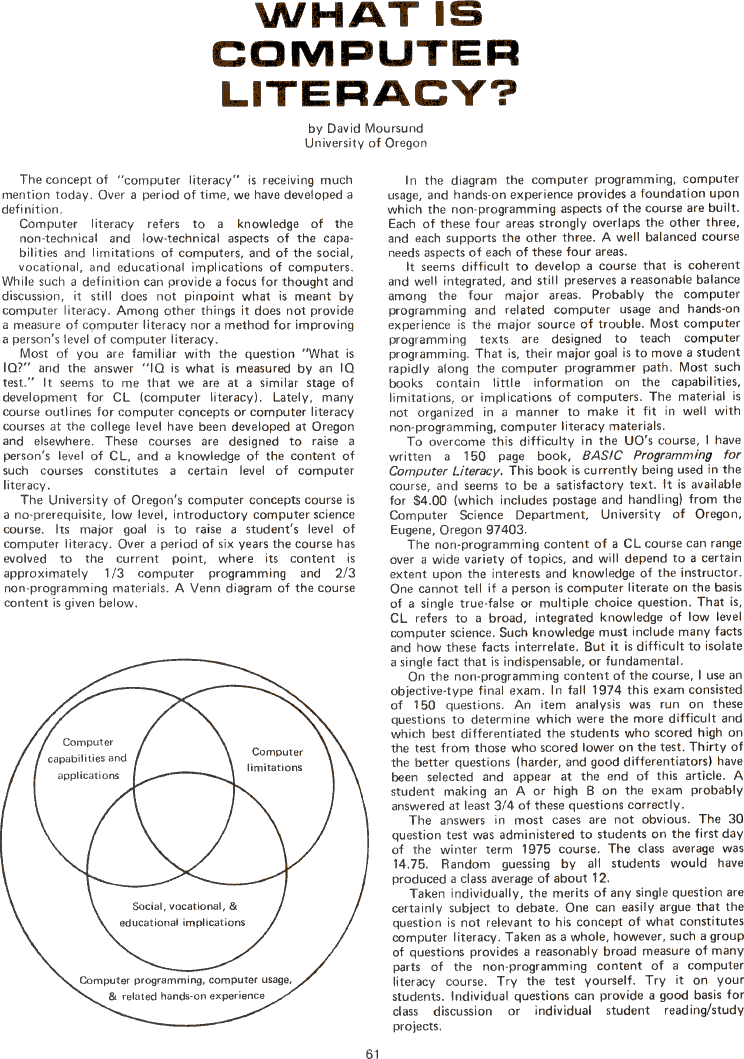by David Moursund

WHAT IS COMPUTER LITERACY? by David Moursund University of Oregon The Concept of "computer literacy" is receiving much mention today. Over a period of time, we have developed a definition. Computer literacy refers to a knowledge of the non-technical and low-technical aspects of the capabilities and limitations of computers, and of the social, vocational, and educational implications of computers. While such a definition can provide a focus for thought and discussion, it still does not pinpoint what is meant by computer literacy. Among other things it does not provide a measure of computer literacy nor a method for improving a person's level of computer literacy. Most of you are familiar with the question "What is IQ?" and the answer "IQ is what is measured by an IQ test." It seems to me that we are at a similar stage of development for CL (computer literacy). Lately, many course outlines for computer concepts or computer literacy courses at the college level have been developed at Oregon and elsewhere. These courses are designed to raise a person's level of CL, and a knowledge of the content of such courses constitutes a certain level of computer literacy. The University of Oregon's computer concepts course is a no-prerequisite, low level, introductory computer science course. Its major goal is to raise a student's level of computer literacy. Over a period of six years the course has evolved to the current point, where its content is approximately 1/3 computer programming and 2/3 non-programming materials. A Venn diagram of the course content is given below. [image]Computer capabilities and applications computer limitations Social vocational & educational implications Computer programming, computer usage, & related hands-on experience ln the diagram the computer programming, computer usage, and hands-on experience provides a foundation upon which the non-programming aspects of the course are built. Each of these four areas strongly overlaps the other three, and each supports the other three. A well balanced course needs aspects of each of these four areas. It seems difficult to develop a course that is coherent and well integrated, and still preserves a reasonable balance among the four major areas. Probably the computer programming and related computer usage and hands-on experience is the major source of trouble. Most computer programming texts are designed to teach computer programming. That is, their major goal is to move a student rapidly along the computer programmer path. Most such books contain little information on the capabilities, limitations, or implications of computers. The material is not organized in a manner to make it fit in well with non-programming, computer literacy materials. To overcome this difficulty in the UO's course, l have written a 150 page book, BAS/C Programming for Computer Literacy. This book is currently being used in the course, and seems to be a satisfactory text. It is available for $4.00 (which includes postage and handling) from the Computer Science Department, University of Oregon, Eugene, Oregon 97403. The non-programming content of a CL course can range over a wide variety of topics, and will depend to a certain extent upon the interests and knowledge of the instructor. One cannot tell if a person is computer literate on the basis of a single true-false or multiple choice question. That is, CL refers to a broad, integrated knowledge of low level computer science. Such knowledge must include many facts and how these facts interrelate. But it is difficult to isolate a single fact that is indispensable, or fundamental. On the non-programming content of the course, I use an objective-type final exam. ln fall 1974 this exam consisted of 150 questions. An item analysis was run on these questions to determine which were the more difficult and which best differentiated the students who scored high on the test from those who scored lower on the test. Thirty of the better questions (harder, and good differentiators) have been selected and appear at the end of this article. A student making an A or high B on the exam probably answered at least 3/4 of these questions correctly. The answers in most cases are not obvious. The 30 question test was administered to students on the first day of the winter term 1975 course. The class average was 14.75. Random guessing by all students would have produced a class average of about 12. Taken individually, the merits of any single question are certainly subject to debate. One can easily argue that the question is not relevant to his concept of what constitutes computer literacy. Taken as a whole, however, such a group of questions provides a reasonably broad measure of many parts of the non-programming content of a computer literacy course. Try the test yourself. Try it on your students. Individual questions can provide a good basis for class discussion or individual student reading/study projects.

